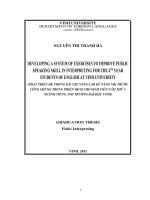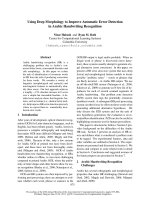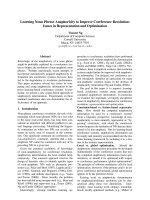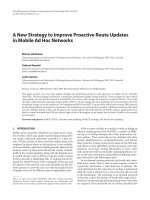Big data to improve strategic network planning in airlines
Bạn đang xem bản rút gọn của tài liệu. Xem và tải ngay bản đầy đủ của tài liệu tại đây (12.9 MB, 482 trang )
Schriftenreihe der HHL Leipzig
Graduate School of Management
Maximilian Schosser
Big Data to Improve
Strategic Network
Planning in Airlines
LEIPZIG
GRADUATE SCHOOL
OF MANAGEMENT
Schriftenreihe der HHL Leipzig
Graduate School of Management
Reihe herausgegeben von
Stephan Stubner, Leipzig, Deutschland
In dieser Schriftenreihe werden aktuelle Forschungsergebnisse aus dem B
ereich
Unternehmensführung präsentiert. Die einzelnen Beiträge spiegeln die wissen
schaftliche Ausrichtung der HHL in Forschung und Lehre wider. Sie zeichnen sich
vor allem durch eine ganzheitliche, integrative Perspektive aus und sind durch den
Anspruch geprägt, Theorie und Praxis zu verbinden sowie in besonderem Maße
internationale Aspekte einzubeziehen.
Weitere Bände in der Reihe />
Maximilian Schosser
Big Data to Improve
Strategic Network
Planning in Airlines
With a foreword by Prof. Dr. Iris Hausladen
Maximilian Schosser
HHL Leipzig Graduate School of Management
Heinz-Nixdorf Chair of IT-based Logistics
Leipzig, Germany
Dissertation HHL Leipzig Graduate School of Management, 2019
Schriftenreihe der HHL Leipzig Graduate School of Management
ISBN 978-3-658-27581-5
ISBN 978-3-658-27582-2 (eBook)
/>Springer Gabler
© Springer Fachmedien Wiesbaden GmbH, part of Springer Nature 2020
This work is subject to copyright. All rights are reserved by the Publisher, whether the whole or part
of the material is concerned, specifically the rights of translation, reprinting, reuse of illustrations,
recitation, broadcasting, reproduction on microfilms or in any other physical way, and transmission
or information storage and retrieval, electronic adaptation, computer software, or by similar or dissimilar
methodology now known or hereafter developed.
The use of general descriptive names, registered names, trademarks, service marks, etc. in this
publication does not imply, even in the absence of a specific statement, that such names are exempt
from the relevant protective laws and regulations and therefore free for general use.
The publisher, the authors and the editors are safe to assume that the advice and information in this
book are believed to be true and accurate at the date of publication. Neither the publisher nor the
authors or the editors give a warranty, expressed or implied, with respect to the material contained
herein or for any errors or omissions that may have been made. The publisher remains neutral with
regard to jurisdictional claims in published maps and institutional affiliations.
This Springer Gabler imprint is published by the registered company Springer Fachmedien
Wiesbaden GmbH part of Springer Nature.
The registered company address is: Abraham-Lincoln-Str. 46, 65189 Wiesbaden, Germany
For my wife Karin who filled the days of my PhD studies with pure joy.
For my mother Jutta who taught me the most important trait as a researcher – curiosity.
For my father Rudolf whose perfectionist mind helped with great suggestions for this thesis.
Foreword
Big data not just evolved as a popular buzzword over time but is meanwhile
seen as a high potential field for improving business processes and decisions taken by responsible persons in different industry sectors, such as
airlines.
Nevertheless, available advantages of big data have not yet been adequately measured from an economic perspective and have very often not
yet been exploited at all or to a reasonable level. Additionally, corresponding theoretical concepts and scientific developments focusing on the area
of network planning in airlines are currently more or less missing. Those
challenging deficits make the topic considered by Mr. Schosser highly relevant both from a theoretical as well as a practical perspective.
Thus, the main objective of the thesis consists in closing both the scientific
research gap and providing a solution to practitioners focusing on the assessment of big data opportunities in the network planning context of airlines.
The author provides with the step-by-step, theoretically and empirically
based development of the framework, its elements and procedures in the
present doctoral thesis an outstanding analytical as well as conceptual personal contribution. The framework is from a content-related point of view
to be honored as a pioneering achievement and the dissertation contains
a lot of new findings that represent a starting point for further work predominantly in the research and practice field of big data evaluation focused on
airline network planning that can be transferred to further use cases respectively fields of applications.
The book, which is based on a dissertation at the HHL Leipzig Graduate
School of Management, is aimed equally at readers from science and practice, dealing with (big) data collection, economic evaluation of big data as
well as big data analytics.
Leipzig, May 2019
Prof. Dr. Iris Hausladen
Preface
The idea for this PhD thesis was born during a consulting project at a European airline, where different departments were at completely different
maturity stages of using Big Data. While at some departments network
planning was done the old-fashioned way, with legacy IT-systems, data
and processes, other departments had already implemented a much more
agile way of integrating Big Data.
The network planning department was frequently approached by data providers with concrete offers, but there was no method to evaluate the impact
of the data for airline network planning, and most of the offers were turned
down for this reason. At the same time, there was no research available to
answer this question. The main objective of this PhD thesis is hence to
alleviate the lack of evaluation methods and provide a concise answer/approach/framework of how Big Data can create value for individual network
planning steps.
The target audience of this thesis comprises airline network planners of all
seniority levels and fellow researchers working on Big Data applications
for the transportation industry, on network optimization problems or on
commercial topics in airlines. I tried to find a middle ground between content of pure scientific interest (e.g., chapters 2 and 3), and presenting relevant findings for practitioners (chapters 4, 5 and 6).
Finally, I want to thank everyone who contributed to this PhD thesis, in
particular my thesis advisor Prof. Dr. Iris Hausladen, who provided guidance and challenge whenever necessary. Further, I want to thank all interview partners of our airline case study group, who need to stay anonymous
due to non-disclosure agreements. Philipp Behrends, Karin Garcia and Rudolf Schosser made an invaluable contribution by reviewing and commenting on various drafts of this thesis. My thanks go also to all staff and students of HHL Leipzig Graduate School of Management who made my time
there so enjoyable. Finally, I want to thank Maximilian Rothkopf for helping
to shape the idea and David Speiser for his support of my PhD project. My
PhD thesis would not have been possible without the financial support during my educational leave granted by the Zurich Office of McKinsey & Company.
Berlin, May 2019
Maximilian Schosser
Contents
1 Introduction............................................................................................ 1
1.1 Problem and research gap definition............................................. 1
1.1.1 Practical problem ...................................................................1
1.1.2 Scientific research gap ..........................................................2
1.2 Objective of the study and research questions .............................3
2 Methodology .......................................................................................... 5
2.1 Development of research design................................................... 6
2.2 Literature review ..........................................................................11
2.2.1 Design of a structured literature review process .................11
2.2.2 Identification of keywords, databases, and journals ............13
2.2.3 Results of the structured keyword search ...........................15
2.2.4 Description of the research gap ...........................................17
2.3 Comparative case study ..............................................................18
2.3.1 Selection of the case study type ..........................................19
2.3.2 Case sampling .....................................................................20
2.3.3 Data collection and analysis techniques ..............................23
2.3.4 Research quality assurance ................................................27
3 Theoretical foundation.........................................................................29
3.1 Development of a theoretical concept .........................................29
3.2 Airlines and their business models ..............................................31
3.2.1 The airline industry ..............................................................32
XII
Contents
3.2.2 Development and recent trends in the airline industry ........34
3.2.3 Airline business models .......................................................35
3.2.4 Major business processes of airlines ...................................43
3.3 Introduction to the network theory ...............................................44
3.3.1 Definition of networks ..........................................................44
3.3.2 Distinction between the network theories ............................48
3.3.3 Fundamentals of the graph theory .......................................50
3.3.4 Network flows and network optimization .............................55
3.3.5 Design of flow networks .......................................................62
3.4 Airline networks ...........................................................................64
3.4.1 General properties of airline networks .................................65
3.4.2 Types of airline networks .....................................................67
3.4.3 Airline network economics ...................................................74
3.4.4 Airline network indicators .....................................................78
3.5 Network planning in airlines ........................................................84
3.5.1 Components of network planning ........................................84
3.5.2 Long-term planning ..............................................................87
3.5.3 Spatial optimization ..............................................................96
3.5.4 Temporal optimization .........................................................99
3.5.5 Operational optimization ....................................................103
3.5.6 Network planning in cargo airlines .....................................106
3.5.7 Data needs of network planning ........................................110
3.5.8 Definition of strategic network planning .............................124
Contents
XIII
3.6 Big data .....................................................................................129
3.6.1 Definition of data ................................................................129
3.6.2 Characteristics of big data .................................................130
3.6.3 The big data value chain....................................................132
3.6.4 Major types of big data ......................................................135
3.6.5 Big data types in airline and tourism research...................136
3.6.6 Issues and risks of big data ...............................................139
3.7 The RBV pertaining to data and network planning ....................140
3.7.1 The basic concept of the resource-based view .................141
3.7.2 The RBV in information systems research ........................144
3.7.3 (Big) Data in the RBV ........................................................147
3.7.4 The RBV in logistics research............................................153
3.7.5 Logistic networks in the RBV .............................................157
3.7.6 RBV-based research concept of big data in airline NP .....159
4 Status quo of strategic network planning in airlines ..........................161
4.1 The network planning process in reality ....................................161
4.1.1 Roles and responsibilities of NP departments ...................161
4.1.2 Sequence and time horizon of NP process steps .............164
4.2 Data types used for network planning .......................................170
4.2.1 Practical use of data types derived from literature ............170
4.2.2 Currently used data types in airline network planning .......174
4.2.3 Reliability and usefulness of data types ............................178
4.3 IT tools used for network planning ............................................181
XIV
Contents
4.3.1 Market of IT tools for airline network planning ...................182
4.3.2 Current use of IT tools in the case study airlines...............184
4.3.3 Data capability of current IT tools ......................................186
4.4 Performance measurement of airline network planning ............188
4.4.1 Planning and optimization goals for NP departments .......189
4.4.2 KPIs currently used for airline network planning ...............191
5 Big data opportunities for airline network planning ...........................195
5.1 Information needs for airline network planning .........................195
5.1.1 Definition of information needs for airline NP ....................195
5.1.2 Satisfaction of information needs with current data use ....199
5.2 Development and evaluation of BDOs for airline NP ................204
5.2.1 Specific BDOs for airline NP information needs ................204
5.2.2 Transportation demand forecast ........................................209
5.2.3 Trend identification ............................................................223
5.2.4 Competitor monitoring .......................................................227
5.2.5 Real movements of passengers and goods ......................230
5.2.6 Real-time planning constraint monitoring ..........................235
5.2.7 Incident monitoring ............................................................238
5.3 Evaluation of BDO potential ......................................................240
5.3.1 Qualitative assessment of BDO potential ..........................240
5.3.2 Differences in BDO potential by business model ..............242
5.3.3 Implementation of BDOs in current IT systems for NP ......248
5.3.4 Feasibility assessment of BDOs ........................................250
Contents
XV
6 Financial impact of big data for airline network planning ..................261
6.1 Choice of appropriate BDOs based on KPIs .............................262
6.1.1 Impact of BDOs on airline NP KPIs ...................................262
6.1.2 Suitable KPI metrics for BDOs in airline NP ......................274
6.2 Financial benefit calculation for big data opportunities .............279
6.3 Business case framework for big data in airline NP ..................288
6.3.1 Introduction of Example Air................................................289
6.3.2 Calculation of BDO impact for relevant KPI groups...........291
6.3.3 Scenario-based sensitivity analysis of KPI benefits ..........300
6.4 Cost evaluation of big data opportunities ..................................303
6.4.1 Cost composition of big data projects ................................304
6.4.2 Cost drivers for big data opportunities ...............................308
6.4.3 Cost estimation framework for BDOs ................................311
6.5 Comparison of benefit and cost potential of BDOs ...................314
7 Discussion and contrast with the scientific body of knowledge ........319
7.1 Status quo of network planning in airlines .................................320
7.1.1 Airline business models and network planning..................320
7.1.2 The network planning process in literature and practice…322
7.1.3 Current data use in literature and practice ........................324
7.2 Big data in airline network planning...........................................327
7.2.1 Big data characteristics of BDOs for airline NP .................327
7.2.2 Relevance of BDOs for other airline departments .............329
7.2.3 Integration of BDOs in corporate big data ecosystems .....331
XVI
Contents
7.3 Revisiting the RBV for big data in airline network planning ......333
7.3.1 Review of the components of an adaptive NP capability ..333
7.3.2 Organizational readiness of airlines ..................................337
8 Conclusion and suggestions for further research .............................341
8.1 Conclusions on research outcome ............................................341
8.1.1 How can “big data” be defined for network planning in
airlines [RQ 1]? ............................................................................341
8.1.2 What is the status quo of the business process, IT
systems, and data use in airline network planning [RQ 2]? .........342
8.1.3 Which new “big data” opportunities are most suited to
improve network planning for airlines or replace existing data
types [RQ 3]? ..............................................................................343
8.1.4 How can the impact of big data opportunities for airline
network planning be quantified [RQ 4]? .......................................345
8.1.5 Overall conclusion .............................................................348
8.1.6 Contribution to the scientific body of knowledge ...............349
8.2 Suggestions for further research ...............................................350
8.2.1 Methodological enhancements ..........................................350
8.2.2 Content suggestions for further research ..........................351
List of Appendices ..................................................................................353
References .............................................................................................411
List of Figures
Figure 1.1 – Research objectives and research questions ....................... 4
Figure 2.1 – Overview of research methodology development ................ 5
Figure 2.2 – Four-phase research design ................................................. 9
Figure 2.3 – Tactics to ensure the quality criteria for selected research
methods............................................................................ 10
Figure 2.4 – Structured literature review process ................................... 12
Figure 2.5 – Build-up of a relevant body of literature .............................. 16
Figure 2.6 – Double tri-angulation approach ........................................... 24
Figure 2.7 – Data collection and analysis techniques of status-quo
assessment ...................................................................... 25
Figure 2.8 – Data collection and analysis techniques of BDO
evaluation ......................................................................... 26
Figure 3.1 – Evaluation of the candidate theories ................................... 30
Figure 3.2 – Structure and purpose of the theoretical foundation
chapter ............................................................................. 31
Figure 3.3 – The aviation system from a supply-demand perspective ... 32
Figure 3.4 – Overview of standard airline processes .............................. 44
Figure 3.5 – Network theory in transportation networks ......................... 50
Figure 3.6 – Connectivity matrices of an undirected, strongly
connected graph .............................................................. 52
Figure 3.7 – Overview of graph types ..................................................... 53
Figure 3.8 – Degree distribution example ............................................... 55
Figure 3.9 – Simple network with assigned link cost .............................. 57
Figure 3.10 – Maximum capacity determined by the max-flow min-cut
theorem ............................................................................ 60
Figure 3.11 – Exemplary network and solution for the minimum cost
flow problem ..................................................................... 62
Figure 3.12 – Airline network archetypes ................................................ 68
XVIII
List of Figures
Figure 3.13 – Lufthansa's South America network in 1934 .................... 70
Figure 3.14 – Lorenz curves for the perfect PP and HS networks .......... 80
Figure 3.15 – Profit contribution margins in route profitability
calculation ........................................................................ 82
Figure 3.16 – Airline network planning phases ....................................... 88
Figure 3.17 – Airline demand forecasting logic ....................................... 90
Figure 3.18 – Methods for market size forecasting ................................. 92
Figure 3.19 – Number of network planning publications, using specific
data types ....................................................................... 113
Figure 3.20 – Number of analyzed contributions by problem
integration....................................................................... 117
Figure 3.21 – Frequency and combinations of network planning and
optimization problems .................................................... 118
Figure 3.22 – Comparison of the network planning process models .... 120
Figure 3.23 – Generic NP process ........................................................ 123
Figure 3.24 – Strategic network planning within the generic airline NP
process ........................................................................... 128
Figure 3.25 – Big data value chain........................................................ 133
Figure 3.26 – Structure of sub-chapter 3.7 ........................................... 141
Figure 3.27 – Research focus in theoretical context ............................. 160
Figure 4.1 – Organizational responsibility model for airline network
planning .......................................................................... 162
Figure 4.2 – Sequence and timing of NP process steps across case
study participants ........................................................... 165
Figure 4.3 – Coding results based on open questions of first interview
round .............................................................................. 171
Figure 4.4 – Clustering of data types by information object .................. 174
Figure 4.5 – Current usage of data types across case study group ..... 177
Figure 4.6 – Perceived usefulness and reliability of the 22 currently
used data types .............................................................. 179
List of Figures
XIX
Figure 4.7 – Usefulness and reliability analysis of the currently used
data types ....................................................................... 180
Figure 4.8 – Market overview over commercially available IT systems
for airline network planning ............................................ 182
Figure 4.9 – IT systems currently used by the case study participants
for network planning ....................................................... 185
Figure 4.10 – Degree of automation in current NP process.................. 186
Figure 4.11 – Exemplary integration of the currently used data
sources in airline network planning IT solution .............. 188
Figure 4.12 – Performance management in NP departments .............. 190
Figure 4.13 – KPI framework for airline network planning .................... 191
Figure 4.14 – Primary and secondary NP performance targets in case
study airlines .................................................................. 193
Figure 5.1 – Information needs throughout the airline NP process ...... 196
Figure 5.2 - Allocation of currently used data sources to airline NP
information needs ........................................................... 200
Figure 5.3 – Addressed information needs of BDOs ............................ 208
Figure 5.4 – Overall qualitative potential assessment of BDOs ............ 241
Figure 5.5 – BDO qualitative potential evaluation patterns by business
model.............................................................................. 243
Figure 5.6 – Cargo vs. passenger-specific BDOs ................................. 248
Figure 5.7 – Ease of implementation assessment for current NP IT
system ............................................................................ 249
Figure 5.8 – Feasibility assessment model for big data acquisition and
analytics ......................................................................... 252
Figure 5.9 – Potential and feasibility evaluation matrix for BDOs ......... 257
Figure 6.1 – Logical process to derive cost and benefit estimate for
BDOs .............................................................................. 261
Figure 6.2 – Direct and indirect KPIs currently used by the case study
group airlines .................................................................. 263
XX
List of Figures
Figure 6.3 – Estimated impact of BDOs on route and network
profitability ...................................................................... 264
Figure 6.4 – Estimated impact of BDOs on load factor ......................... 265
Figure 6.5 – Estimated impact of BDOs on forecast accuracy ............. 267
Figure 6.6 – Estimated impact of BDOs on schedule robustness ........ 268
Figure 6.7 – Estimated impact of BDOs on asset utilization ................. 269
Figure 6.8 – Estimated impact of BDOs on FTE efficiency ................... 271
Figure 6.9 – Estimated impact of BDOs on DOC and IOC ................... 272
Figure 6.10 – Relevant metrics for KPI calculation in airline NP........... 275
Figure 6.11 – Profile of Example Air ..................................................... 290
Figure 6.12 – Input data and estimates for the calculation of KPI
metrics for BDO-benefit evaluation ................................ 291
Figure 6.13 – Illustrative flight portfolio by average flight profit ............. 292
Figure 6.14 – Example benefit calculation for profit delta from flight
portfolio changes ............................................................ 293
Figure 6.15 – Example-benefit calculation for total network profit ........ 293
Figure 6.16 – Illustrative distribution of forecast deviation for Example
Air ................................................................................... 294
Figure 6.17 – Example-benefit calculation for load factor ..................... 296
Figure 6.18 – Schematized rotation plans for Example Air aircraft
types ............................................................................... 297
Figure 6.19 – Example-benefit calculation for idle hours per aircraft
type................................................................................. 297
Figure 6.20 – On-time performance of Example Air (percent and total
number of flights) ........................................................... 298
Figure 6.21 – Example-benefit calculation for on-time performance .... 299
Figure 6.22 – Cost components of BDA projects structured along the
big data value chain ....................................................... 305
Figure 7.1 – Structure of discussion in chapter 7 .................................. 319
List of Figures
XXI
Figure 7.2 – Comparison of data types used by airlines and in NP
literature ......................................................................... 325
Figure 7.3 – Big data characteristics of 23 BDOs for airline NP ........... 329
Figure 7.4 – Exemplary airline big data ecosystem .............................. 333
Figure 7.5 – Revised research concept based on RBV ........................ 336
Figure 7.6 – Maturity model dimensions and maturity patterns by
airline business model.................................................... 338
List of Tables
Table 2.1 – Decision-making criteria for research approach .................... 7
Table 2.2 – Comparison of research methods .......................................... 8
Table 2.3 – Keyword extraction for the literature review ......................... 13
Table 2.4 – The case study method adopted from Eisenhardt (1989).... 18
Table 2.5 – Specification criteria for case study airlines ......................... 21
Table 2.6 – Airline case study participant overview ................................ 22
Table 3.1 – Airline business model classifications in the literature ......... 36
Table 3.2 – Key characteristics of airline business models .................... 38
Table 3.3 – Overview of transportation networks by transportation
mode ................................................................................... 46
Table 3.4 – Graph theory terminology..................................................... 51
Table 3.5 – Airline network terminology .................................................. 65
Table 3.6 – Overview of literature in airline NP processes ..................... 86
Table 3.7 – Identified data types in network planning literature ............ 111
Table 3.8 – Integrated network planning and optimization models ....... 115
Table 3.9 – Definition criteria for big data in literature .......................... 130
Table 3.10 – Social media services by Gundecha and Liu (2012, p. 3) 136
Table 3.11 – Big data types mentioned in airline and tourism literature 138
Table 3.12 – Concepts of IT resources ................................................. 145
Table 3.13 – Data resource characteristics by Levitin and Redman
(1998)................................................................................ 149
Table 3.14 – Logistic capabilities defined by Gligor and Holcomb
(2012)................................................................................ 156
Table 4.1 – Description of currently used data types derived from
literature ............................................................................ 172
Table 4.2 – Additionally coded data types not used in literature .......... 175
Table 5.1 – Classification of airline big data types ................................ 205
XXIV
List of Tables
Table 5.2 – BDOs ranked by business model ....................................... 245
Table 5.3 – Feasibility assessment of BDOs ........................................ 254
Table 6.1 – Impact of BDOs on airline network planning KPIs ............. 273
Table 6.2 – Required input data and estimations for KPI metrics ......... 279
Table 6.3 – Big data project scenarios .................................................. 300
Table 6.4 – BDO benefit requirement for break-even of BD project
scenarios........................................................................... 303
Table 6.5 – Cost risks of cost drivers for value chain components ....... 309
Table 6.6 – Estimated cost risks of BDOs............................................. 312
Table 6.7 – First indicative comparison of financial benefit and cost
risks................................................................................... 316
List of Abbreviations
ACL
ACMI
ADS-B
API
ASK
AWB
BD
BDA
BDO
BI&A
BT
CAR
CASS
CCO
CEO
COO
DOC
e.g.
EASA
e-AWB
EBIT
et al.
etc.
EU
FDI
FSC
FTE
GB
GDP
GDS
GPS
HS
i.e.
-
Airport Coordination Limited
Aircraft, Crew, Maintenance and Insurance
Automatic Dependent Surveillance Broadcast
Application Programming Interface
Available Seat Kilometers
Air Waybill
Big Data
Big Data Analytics
Big Data Opportunity
Business Intelligence & Analytics
Block Time
Cargo Airline
Cargo Accounts Settlement System
Chief Commercial Officer
Chief Executive Officer
Chief Operations Officer
Direct Operating Cost
For example (Latin: exempli gratia)
European Aviation Safety Agency
Electronic Air Waybill
Earnings Before Interest and Tax
Et alii
Et cetera
European Union
Foreign Direct Investment
Full-Service Carrier
Full-Time Equivalent
Gigabyte
Gross Domestic Product
Global Distribution System
Global Positioning System
Hub-And-Spoke
That is (Latin: id est)
XXVI
List of Abbreviations
IAG
IATA
ICAO
IMF
IOC
IP
IS
IT
KPI
LCC
LoRaWAN
MCT
MIDT
MIT
NLP
NP
NPV
OAG
O&D
OECD
-
OR
p.
P&RM
pp.
PP
QSI
RBV
RFID
RQ
RR
RSK
RTK
SCA
SCM
-
International Airlines Group
International Air Transport Association
International Civil Aviation Organization
International Monetary Fund
Indirect Operating Cost
Internet Protocol
Information Systems
Information Technology
Key Performance Indicator
Low-Cost Carrier
Low Range Wide Area Network
Minimum Connection Time
Marketing Information Data Tape
Massachusetts Institute of Technology
Natural Language Processing
Network Planning
Net Present Value
Official Airline Guide
Origin & Destination
Organisation for Economic Co-operation and
Development
Operations Research
Page
Pricing & Revenue Management
Pages
Point-To-Point
Quality Of Service Index
Resource-Based View
Radio-Frequency Identification
Research Question
Random Radial
Revenue Seat Kilometers
Revenue Ton Kilometers
Scheduled Charter Airline
Supply Chain Management
List of Abbreviations
SRS
TAT
TB
UK
US
USD
VHB
-
VM
WTO
-
XXVII
Schedule Reference Service
Turn-Around Time
Terabyte
United Kingdom
United States
United States Dollar
German Academic Association for Business
Research
Virtual Machine
World Trade Organization
1
Introduction
1.1
1.1.1
Problem and research gap definition
Practical problem
Big data has become one of the most prominent buzzwords of the modern
corporate world, which is a remarkably fast feat for a new phenomenon. It
became fashionable at the onset of the 2010s, fueled by popular articles in
the Harvard Business Review (McAfee & Brynjolfsson, 2012) and the MIT
Sloan Management Review (Davenport, Barth, & Bean, 2012). Its broad
scope makes it directly or indirectly crucial for all industries, and as early
as 2011, Manyika et al. (2011, p. 1) estimated a global big data (BD) value
generation potential of more than 1 trillion US Dollar (USD).
Since airlines had been producing vast amounts of data even before the
term big data was coined, its potential value in the industry was noticed
early on (Noyes, 2014). In a recent survey, more than 60% of aviation executives named big data as a top priority for their company (Hodgson &
Waldmeir, 2018). The airline business is receptive to a wide range of big
data applications: the single customer view enables hyper-personalized
customer experience and marketing activities (Chen et al., 2017; Hodgson
& Waldmeir, 2018; Noyes, 2014); higher granularity of customer insights
can be utilized for customized pricing and revenue management (Boin et
al., 2017); real-time information on transfer passengers and irregular situations can help reduce delays and smoothen flight operations (Bowcott &
Dichter, 2014; Chen et al., 2017); finally, predictive maintenance can reduce unplanned aircraft groundings and lower maintenance cost (Bradbury, 2018; Chen et al., 2017).
Although airlines are at the forefront of big data adoption, not all business
processes and departments in the industry participate at the same speed.
Bertram (2017) proposes various big data applications for network planning (NP), including mobile location data and real-time flight radar data.
© Springer Fachmedien Wiesbaden GmbH, part of Springer Nature 2020
M. Schosser, Big Data to Improve Strategic Network Planning in Airlines,
Schriftenreihe der HHL Leipzig Graduate School of Management,
/>









